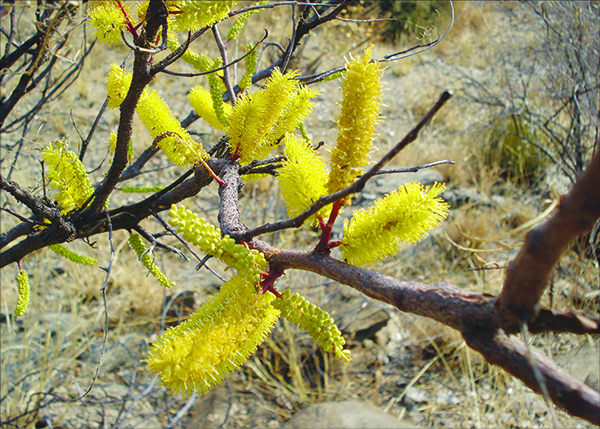• LUISE HOFFMANNIN summer, this many-stemmed shrub or tree is easy to recognise, due to its unusually large feathery leaves quite similar to those of the Jacaranda tree.
In spring – from September to December – long, bright yellow flower spikes decorate the bare, smooth, reddish-brown branches. They are very conspicuous at this time when the rest of the vegetation is still dry and grey. Large pods, distinctly raised above the seeds and turning dark brown when ripe, develop from March onwards. They split open and curl up from the tip while the strong ‘threads’, which form a thickened margin, separate from the pod and stand away. Remaining on the plants for many weeks, they are a useful aid to identification. The skew-leaved elephant-root usually is a shrub of about 3m but may become a tree of up to 8m.
Characteristically the midrib of the leaflets runs along the extreme inner edge of each leaflet instead of in the middle, hence the English common name ‘skew-leaved’ sumach bean.
Names: G Gerbwurzelstrauch; A looiwortelboom; H otjite, omundjoze; Ky omunbalandongo; Nd omunbala ndongo; D/N //ana gâb, nunib. The botanical name Elephantorrhiza means ‘elephant root’ and suffruticosa also refers to the large underground rootstock of this species.
The skew-leaved elephant-root occurs from about Rehoboth right up to the Kunene and the Karstveld, but is absent from the Namib, the Kalahari and Namibia south of Rehoboth. It is quite common on the hills around Windhoek and also occurs on plains.
Uses: As implied by the German and Afrikaans common names, meaning ‘tanning root’, the large root of this shrub is used for tanning. The roasted seeds are said to be used as a coffee substitute.
Reference to tanning is frequently made in descriptions of plants in Namibia. Almost all plants contain tannins in various concentrations in their roots and their bark, and also in pods and leaves, where they serve to protect the plant from fungi and germs by causing tissue and pores to contract. The astringent taste of strong black tea that has been brewed for a long time is an example. Black tea as well as teas made from the bark of many tannin-rich plants cause the insides of the intestines to contract and kill germs and fungi thereby relieving pain and discomfort. Similarly, skins soaked in tannin-rich brews contract, germs are killed, the skins do not rot and the resultant leather becomes water tight or at least water repellent.
Cultivation: the skew-leaved elephant-root makes a pretty shrub for an indigenous garden. In spring the long yellow flower spikes show off well against the smooth brown bark, while the large feathery leaves are very decorative in summer. Seedlings are available from the nursery of the National Botanical Research Institute in Windhoek – contact Number 061 202 2014.
Elephantorrhiza elephantine, commonly known as elands-bean, H omundjoze; A elandsboontjie; G Gerbwurzel, with very similar leaves, flowers and fruit only reaches a height of about 1m and is confined to the greater Gobabis district.
E. goetzii is only found in the Caprivi, E. rangei is known from one site in the Karas Mountains while E. schinziana has only been found in the Otavi Mountains.
Stay informed with The Namibian – your source for credible journalism. Get in-depth reporting and opinions for
only N$85 a month. Invest in journalism, invest in democracy –
Subscribe Now!






